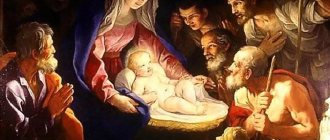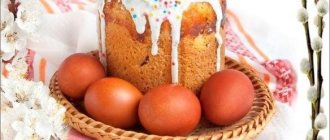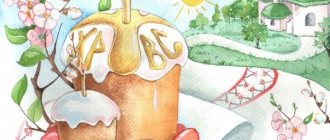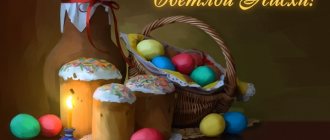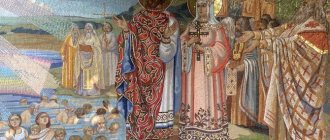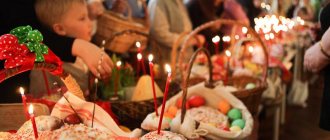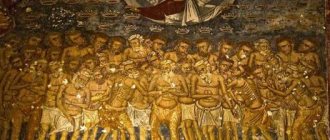The words “Passover” and “Easter” are so consonant that one might think that these are the names of the same holiday in different languages. It would be more correct to say that this is one word, “Easter” - a distorted “Pesakh”, its pronunciation in Latin. In everyday life, Passover is usually called “Jewish Passover,” but nothing but the name connects these holidays and they are dedicated to completely different events. These two days have no intersection; the resurrection of Christ did not happen on the day of Passover, as one might think. What does this holiday mean for the Jewish religion and how does it intersect with the Christian canon?
history of the holiday
According to traditional beliefs, Passover is celebrated as a sign of the exodus of the Jews from captivity in Egypt. A detailed account of the ordeals of the Jewish people is set out in the second book of Moses - the Book of Exodus. This is the second of five volumes of the Torah.
The word “Pesach” itself is translated as “to jump over.” According to another version, “move on.” What kind of holiday is Passover? The history of the Jewish people begins from the time of Jacob. He settled with his family in the land of the pharaohs and lived richly and happily. But the years passed, the rulers of Egypt changed, new laws were written and new rules were established. People who arrived from other countries began to be oppressed. Gradually, the family of Jacob turned from peaceful settlers into slaves.
Meanwhile, the miracles of the Lord appeared to Moses. And God ordered him to follow to the lands of Egypt and free the Jewish people. He sent miracles as a sign of his intention and blessing. Moses appeared before Pharaoh, but he refused to let the Jews go. Then the Lord sent ten plagues on him. Terrible disasters engulfed Egypt: a pestilence swept through the country and killed herds of livestock, and the entire harvest was lost.
Despite the threatening famine and devastation, the pharaoh did not agree to release the slaves. And the time has come for the most terrible tenth execution. The Lord cursed the people in the land of the Egyptians and said that in one night all the firstborn in every house would be killed. God gave Moses a warning. To protect the Jews and their children, a mark had to be placed on every house where they lived. In the evening, before the onset of the bloody night, the Jews slaughtered a lamb and painted a security sign on every door with its blood. The Angel of Death saw the mark and bypassed the Jewish families. And on the night of the fourteenth day of the month of Nisan, the Angel killed all the firstborn of the Egyptians, but the Jewish firstborn remained unharmed. It is this sign that is called “Pesach” (from Hebrew - “pass by”). Only after this did Pharaoh let the Jewish people go with Moses. So the fourteenth day of Nisan was marked by the liberation of the Jewish people from the yoke of the Egyptians. And all the children of the Jews were saved.
When does Passover start and set in 2021 for the Jews?
The holiday usually begins in the month of Nissan on the evening of the 15th, and lasts 7 days in Israel and 8 in other countries. In 2021, Passover begins on March 27 and ends on April 2 and 3, respectively.
The date is floating, calculated according to the lunisolar calendar, and is usually set between mid-March and mid-April according to the Gregorian calendar.
Why does the Jewish Passover last 7 days? It was this period of time that the Egyptian army needed, which the ruler sent in pursuit, coming to his senses and regretting that he had let their people go home. But the Lord opened the waters of the Red Sea, which they were just approaching, and the Jews were able to quickly pass through it. The Egyptian army drowned in the depths of the sea.
In the following years, the holiday dates will be as follows:
- 2022 – April 14-23;
- 2023 – April 5-13;
- 2024 – April 22-30;
- 2025 – April 12-20.
The meaning of the holiday for the Jews
The theme of the Exodus permeates the entire religion of the Jews. The events that followed are associated with the arrival on the land of Israel and the creation of a separate state. In ancient times, the holiday was marked by festivities, worship services and a ceremonial meal with the ritual killing of a lamb.
The time of celebration of the exodus of the Jews from Egyptian land coincided with the holiday of the arrival of spring. Therefore, the celebration has a number of similar names. Passover is the main name, the meaning of the ritual action in honoring the Jewish people as a sign of liberation and independence.
The second option is Chag HaMatzot, from the word “matza”. The holiday got its name due to the fact that, when leaving Egypt, the exhausted Jews were in such a hurry that they did not have time to take practically anything with them. They also had no food; bread had to be prepared on the go from what was available. This is how matzo, a yeast-free bread, appeared. Interesting rituals of the modern celebration of Passover are associated with it.
Another option is Hag HaAviv, translated as the holiday of spring. This is a traditional spring holiday among many peoples, including Jews. Marks the beginning of sowing, joy and the new birth of nature.
The fourth option is Hag HaHerut, the holiday of freedom. The meaning also refers to the exodus of the Jews. Passover, according to Jewish beliefs, is celebrated as a time of liberation and justice. There is a whole set of laws for celebrating Passover, its name is Psakhim.
How to congratulate a Jew on Easter
To make a Jewish friend happy with the holiday, you need to learn just a few words from those that are traditionally spoken during Passover. They are not difficult to remember, but are obligatory for every Jew these days.
- “Peysak samaeyah” - translated as “Happy Easter”, the shortest and simplest greeting.
- It can be even simpler - “Chag Sameyah”, which literally means “Happy Holidays”.
- Or this: “Chag Pesach Sameach”, which translates as “Happy Passover”!
If the Hebrew words seem difficult, you can simply wish from the bottom of your heart a happy holiday, love, prosperity, prosperity, peace and prosperity. So that the light of hope does not go out in the soul, and faith in the best has always been a guiding star in life. And the main thing is to do it from the heart and with a pure heart. Then the wishes will definitely come true and give the congratulated person joy and cheerfulness.
Preparing for the celebration
The celebration is preceded by general cleaning. Its peculiarity is that the owner or mistress of the house needs to take out and destroy what is capable of fermenting (leavened food). This category includes all baked goods, cereals and cereals, sauces and much more. These products can be eaten before the holiday or taken to the home of people of another faith for storage. Leavened products are called chametz.
It is desirable that the entire Jewish family take part in the preparation for the holiday. This way, cleaning is done more thoroughly, because even a crumb of chametz is prohibited from being in the home. All existing utensils are washed with hot water to remove any remaining food. Before the first day of the Jewish holiday of Passover, it is traditional for the owner of the house to walk around all the rooms with a candle in his hand. He should have a pen and a spoon in his hands. This process symbolizes the search for chametz in the house. Anything found must be destroyed immediately.
Kabbalistic teaching says that the fermentation of dough symbolizes pride in a person - what he thinks about when someone has hurt him or offended him. The destruction of chametz directs believers to suppress their pride. Passover revives the divine in the soul. Therefore, it is necessary to sweep out everything unnecessary and fermented from it.
Rituals
The only bread allowed on Passover is matzo. It symbolizes the haste with which the Jews broke free from slavery. Matzo is a flatbread made from dough that has not had time to rise. Matzo is ready in no more than eighteen minutes. A special flatbread is prepared for the holiday, it is called shmura.
For the first evening of Passover, three matzos are made and laid one on top of the other. All family members prepare for the first dinner. The table is set with the best tablecloth and beautiful dishes. If there are silverware, then it is allowed to use them. Particularly religious families keep a separate set of dishes for the celebration. Bitter herbs are served on the table as a sign of the bitterness suffered by the people of Israel, and wine. Drinks for the celebration must only be prepared by a Jew, otherwise the juice or wine will be considered non-kosher.
There is a separate set of rules for the Jewish holiday of Passover - Haggadah. Before the celebration begins, the mistress of the house lights candles; there must be at least two of them. If Passover falls on the night from Friday to Saturday, then the same candles are used as for Shabbat. They are lit eighteen minutes before the sun sets below the horizon. Prayers and blessings are read over the candles.
When Passover occurs on Saturday, candles are lit a maximum of fifty minutes after sunset. On other days of the week they are brought in immediately before the start of the celebration, but from a fire that was lit before sunset. Such subtleties are associated with the belief that on Holy Saturday you cannot touch what fire gives. And on holidays you cannot create a flame, but there is permission to transfer it from one person to another, by lighting a candle from another candle, for example. In this way, the holiday is separated from everyday life and is sanctified by flame.
Jews and Gentiles Gathered Together in Yeshua
However, we live in exciting times, and tremendous strides have been made over the last century to heal this gap between Jews and non-Jews. Over the past 19 years, more Jews have come to believe in Yeshua as the Messiah than in the last 19 centuries combined! And more and more non-Jewish believers are showing interest in the Jewish foundations of their faith. Many churches hold Passover Seders that teach more about the holiday, and understanding of the people of Israel has increased as the Bible has been widely translated and printed over the past few centuries.
We are destined to become “one new man” in the Messiah, and this is the goal to which God will surely lead us. His Son, Yeshua, will only have one bride, not two! It is important to remember what Yeshua's death and resurrection mean and what it has already accomplished. Paul assures us in Colossians:
“And you, who were dead in sins and in the uncircumcision of your flesh, He quickened together with Him, having forgiven us all our sins, having destroyed the handwriting that was against us, which was against us, and He took it out of the way and nailed it to the cross; having taken away the strength of the principalities and powers, he imperiously subjected them to shame, having triumphed over them with Himself. So let no one judge you for food or drink, or for any holiday, or the new moon, or the Sabbath: this is a shadow of the future, but the body is in Christ.” (1 Col. 2:13-17)
Source - oneforisrael.org Translation - Anna Ivashchenko for
Donate Last: 07/05. Thank you!
Subscribe: Telegram • Facebook • • • Twitter • Instagram • Youtube
Seder Passover
On the first evening of the holiday, Jews gather at a rich table. This evening is called Seder. Its essence boils down to the fact that Jews remember the exodus from Egypt (commemoration is prohibited in Judaism, so every Seder Jewish families relive the liberation). First of all, a special dish is placed on the table. Kosher food is placed on it in a strictly defined order. Each prepared product carries its own meaning and symbolism. Even its place on the platter was chosen for a reason. There is a certain order of actions (the word Seder itself is translated as “order”) in the process of celebrating the first evening of Passover. It consists of several stages:
1. Kadesh. At this stage, a prayer of three blessings is said. Its name is Kiddush. This action gives a blessing for the celebration. Drink the first glass of wine. For these purposes, it is recommended to start with a small container in order to drink the whole thing without stopping.
2. Urhatz. Hand washing. During the ritual, the head of the family sits at the beginning of the festive table. Objects for the procedure are presented to him by the rest of the family.
3. Karpas. This word refers to a dish consisting of vegetables. Potatoes and celery are used to prepare it. It is a symbol of the hard work that the Jews performed on Egyptian soil. Before eating, karpas is dipped in water with dissolved salt, a symbol of tears, and a blessing prayer is read.
4. Yahats. The medium matzah prepared for the ceremonial meal is broken into several pieces. The largest slice is wrapped in a napkin and hidden in the house. The child who finds this piece will receive a gift. The name of this piece of matzo is afikoman. The remaining pieces are hidden between two other matzos.
5. Magid. At this stage, legends from the Haggadah, stories about the exodus of the Jews and how Passover began are retold. Initially reproduced in Hebrew and, if necessary, later translated for guests. Next, the youngest child asks the head of the family four questions about how the night of Passover differs from others, whether Jews have anything to be ashamed of, why Hebrew and the history of the Israelis are forgotten, and about respect for the Jews. The essence of the questions comes down to the fact that the people were slaves, and now they are freed and can remember their history and live openly, with their heads held high. Dialogue is built in every family; this tradition is unique and central to the Seder ritual. After this speech, the second glass of wine is emptied.
6. Matzah. Prayer is performed over the second matzah. The top one is broken into a number of pieces equal to the number of those present at the celebration. You need to eat this piece in a relaxed position, reclining on pillows, as a symbol of newfound freedom and independence.
7. Maror. The next dish, which the celebrants eat, symbolizes all the bitterness of the Jews in slavery. Maror is mountain greens or a mixture with horseradish, it is dipped in charoset (a kind of sauce). You can combine foods, for example, make a sandwich of matzo and maror. It's called Korekh.
8. Shulchan-nut. The stage at which the feast begins. You can eat everything that the owners of the table are rich in. Serve soup, baked meat or fish.
9. Tsafun. The process of eating a found piece of matzo. It is divided among all those present and combined with the matzo that is on the table. This is the final meal, after which it is prohibited to eat.
10. Bareh. Final point. They read a prayer and empty the third glass of wine.
Before drinking the fourth glass, they open the door and “let in” the prophet Elijah. He notified the Jews of the onset of deliverance from slavery and is considered a harbinger of the coming of the Savior. His glass remains on the table untouched. All those present finish the fourth glass of wine, accompanying this action with prayers. At the end of the festive evening, songs on the theme of the Jewish Passover are sung. All participants in the meal communicate on theological topics and the traditions of the celebration. The elders share worldly wisdom (below in the photo - Passover in a Jewish family).
Passover traditions
- Jews begin preparing for Passover several weeks in advance. All houses are thoroughly cleaned and all “non-kosher” food, that is, chametz, is burned or sold to non-Jews.
- On the morning before Passover, the fast of the first-born men begins in memory of the salvation of the first-born of Israel. But in fact, most firstborns fast only until the end of morning prayer in the synagogue. According to tradition, one who takes part in a meal on the occasion of a joyful event is exempt from the need to fast.
- On the evening of Nisan 14, the whole family and guests who came to the house gather at the festive table and read the Passover Haggadah - the story of the Exodus of the Jews from Egypt. This meal is called a seder (“order” in Hebrew) and is the most important part of the holiday. The Passover Seder is held in a certain, strictly established order, where each action has its own place and time.
- A festive dinner must be served in beautiful dishes. Religious Jewish families usually have a full set of dishes especially for Passover. Many people purchase new dishes for the holiday, which are first immersed in boiling water to remove any traces of oils or materials that may have contained chametz.
- Bowls of salted water are also a special attribute of the Seder. In this symbolic way, Jews honor the memory of women who shed tears upon learning of Pharaoh's order to kill all first-born children.
- During the meal, every adult Jew must drink four cups of wine, which signify God's promises to the Jewish people. Children drink grape juice.
- The meal ends with "afikoman" - the final dish. During the Temple, afikoman was the Passover sacrifice, and after its destruction, it was a piece of matzo that was broken off at the beginning of the Seder. Afikoman is taken before partaking of the third cup—the cup of atonement.
- The mitzvah also requires eating at least one piece of matzah the size of an olive at the seder. The Seder ritual involves several moments during the evening at which matzo is eaten. During the seder it is also recommended to try bitter greens (from horseradish to lettuce) - maror.
- The day following the Passover Seder is the first day of the holiday. For religious people, this is a day of prayer and rest, when all work is prohibited. For the secular part of the Israeli population, this is a day off, which is usually spent with family, friends, and loved ones. This is followed by five days, the so-called half-holidays, when some institutions work for half a day, and some do not work at all. And the Easter week ends with another holiday.
- During the holiday, Jews are prohibited from eating bread and any other products containing grains that have been leavened. The Torah (Pentateuch) commands to eat matzah (unleavened bread) on these days. According to legend, before the Exodus the Jews did not have time to leaven the dough, so they baked unleavened cakes. True, there is evidence that the shepherd's festival of unleavened bread was celebrated even before Moses. But to this day, matzo - unleavened flatbread, which is supposed to be eaten on Passover - is a reminder of the bread that the Jews ate as they hastily left Egypt.
- Passover, like Sukkot and Shavuot, is a holiday of pilgrimage to Jerusalem.
What should be on the holiday table?
Before the start of the Seder evening, Jews determine which seat at the table each of the guests will get. The dishes that will be served to the table are distributed in a similar way.
The only possible bread, as already mentioned, is matzo. Jews use yeast-free flour to make pies, soup dumplings, sandwiches, add to salads and make pancakes. The taste of unleavened matzo brings back to the Jews the memory of their ancestors, symbolizing the hardships and grief that this people had to endure. A special dish called zroah is prepared from lamb on the bone. Chicken can be used instead of lamb. This dish symbolizes the lamb sacrificed to the Savior, whose blood was used to mark Passover signs on the doors of Jewish houses.
Beitsa is a hard-boiled egg. In Judaism it means rebirth and a happy life. Maror – bitter greens (lettuce, horseradish, basil). Karpas - coarse vegetables (often boiled potatoes) as a symbol of the backbreaking labor of slaves on Egyptian soil. Charoset sauce is the personification of the liquid mixture used to build pyramids in Ancient Egypt. It was used by Jewish slaves. Ingredients: apples, wine, seasonings and walnuts. There are many recipes for its preparation. As a rule, there are additional nuts and fruits on the table.
Drinks include kosher homemade wine or grape juice. A single wine glass personifies the four obligations that the Lord voiced to the Jews at the end: “And I will lead you out from under the yoke of the Egyptians...”, “And I will deliver you...”, “And I will save you...”, “And I will receive you...”.
On the first day of the holiday, Jews are prohibited from working. It is customary to visit the synagogue, pray, and follow traditions. The clergy bless the people on Passover.
Holiday routine
The Jewish Passover continues for the next six days. There will be no more Seder-like feasts. Pious Jews work less during Passover, or not at all. It is a mistake to think that the entire period of celebration is filled with prayers and eating food. On the second day, it is customary to visit relatives, rest and relax with them. We must not forget about anyone on Passover. Lonely people are invited to the table by neighbors or acquaintances. Israel is filled with a single spirit, community. Jews communicate a lot with each other, visit relatives whom they have not seen for a long time.
Jewish fast
The fast of the Jews before Passover is also called the fast of the firstborn, made in honor of the rescued Jewish newborns in Egypt.
The fast is very strict, it begins on the eve of the holiday and lasts from dawn to sunset, it prohibits:
- eat and drink;
- brush your teeth;
- rinse the mouth.
Only male people, the first children of their father or mother, fast before the Jewish Passover. If the child is underage, the father holds the fast. Even if before the first child the mother lost her firstborns, then the first born child must endure the fast.
Fasting begins even if the day falls on Friday.
Passover and Easter
Despite the obvious similarity in name, these two holidays have completely different roots. Passover chronologically happened before Easter, so it traditionally takes place on earlier dates. Unlike the Jews, who celebrate liberation from slavery on Passover, Easter is the Resurrection of Christ. The holidays are not connected in any way, although they have similar names.
At Easter, it is customary to set a rich table using traditional dishes (colored eggs, Easter cakes, Easter cakes). But the spiritual content of the celebrations is completely different, and they have no relation to each other. Catholic and Jewish Easter are also very different, although the dates of celebration often coincide. Catholics, like Christians, celebrate the Resurrection of the Lord.
How to prepare matzah
Matzo is the most famous flour product of Jewish cuisine, in the Russian tradition - unleavened bread (not fermented bread). These are flatbreads made from unfermented dough. It is prepared from 5 grains: wheat, oats, rye, barley and spelt.
Most importantly, kneading the flour and the baking process itself should take no more than 18 minutes. It is believed that fermentation takes longer to begin and eating such food on Passover is unacceptable.
The shape of the baked goods does not matter. Matzo can be round (typical for homemade flatbreads) or square when produced in a factory.
Interesting Facts
Passover was the first holiday that Jews began to celebrate. All Jewish celebrations begin in the evening, so on the days of their celebrations, all institutions close earlier, and Jews go to celebrate. Passover is no exception. During the celebration, bread disappears not only from homes, but also from shelves to eliminate temptation. Since the start date of the festival is calculated according to the Jewish calendar, its start date changes every year.
Matzo as a symbol of the Jewish Passover holiday has several names. In the Torah it is called “poor bread” or “miserable bread.” Although its composition is not varied, special matzah is baked for Passover. This is a low-calorie product, only 111 calories per piece. In everyday life, apple juice, berries, eggs, etc. are added to matzah. It is forbidden to eat such bread at Seder; only bread without yeast and without additives is allowed. In 1838, A. Singer invented a device for producing matzo, but devout Jews try to prepare it at home. This bread should not be eaten for a whole month before Passover, so that later you can better taste it. The day before the holiday, the first-born men in the family must fast.
Three matzos on the table on Seder evening represent the kohanim, ordinary Jews and Levites. A month after Passover, those Jews who were unable to celebrate for some reason celebrate Pesach Sheni. On this day, lamb or chicken can be cooked, and matzah can be eaten without destroying the chametz.
Jewish matzo bread
Translated from Hebrew, matzo means “deprived of moisture.” These are flatbreads made using dough that has not undergone a fermentation process. Matzo is permitted for consumption during Passover.
According to the commandments of the Torah, eating matzo is one of God's instructions. On the 14th night of Nisan, the Jews, marking their doorposts with the blood of lambs, waited for God to execute the firstborn of Egypt, ending the 10th plague. Also, on this evening, God commanded the Jews to eat matzah and commemorate the events of the Exodus in the celebration of Passover.
Translated from Russian, matzo means “unleavened bread.” According to the Torah, God ordered to eat matzah from the 14th day of Nisan to the 21st, that is, all 6 days of Passover. At the same time, eating leavened food is strictly prohibited in memory of how exactly the Jewish people received freedom. If there is leavened food in the house, it is believed that the soul of this person will be expelled from the society of Israel.
On the seventh day, the celebration was handed over to the Lord, and the Jews themselves did not have to do anything. It is only allowed to prepare for the table what the family will eat at the meal.
